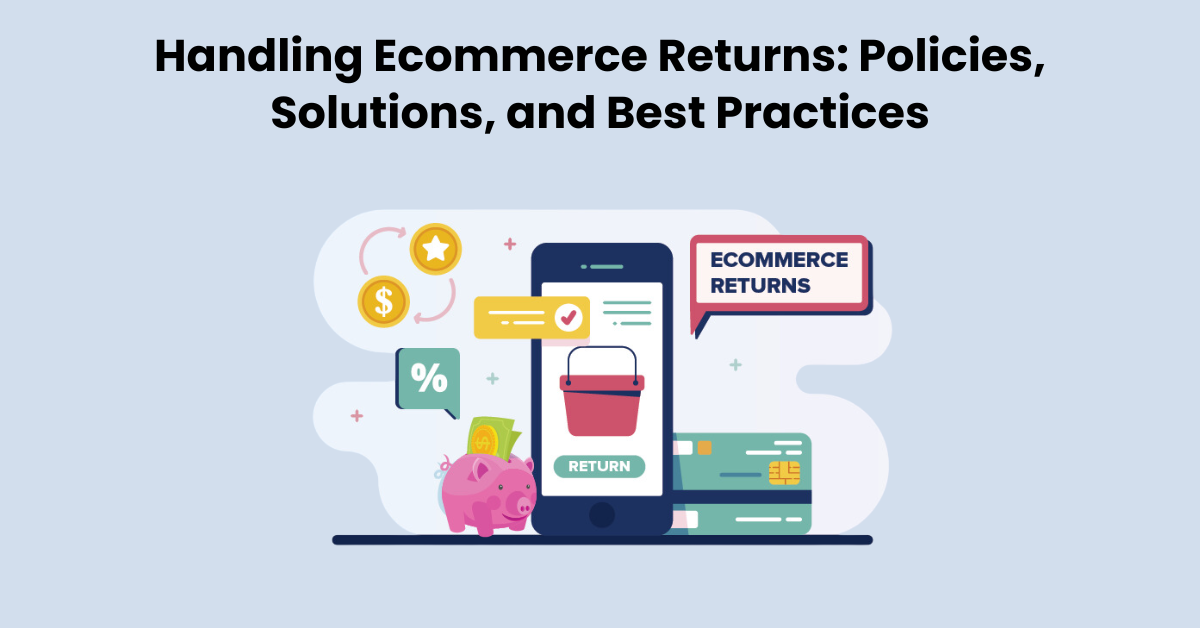Handling Ecommerce Returns: Policies, Solutions, and Best Practices

In ecommerce business, returns are an inevitable part of doing business. In fact, nearly 30% of all online purchases are returned. While this might seem daunting, a well-crafted returns policy can actually enhance customer trust and loyalty. This blog delves into the essentials of handling ecommerce returns effectively. From establishing clear policies that protect both your business and your customers, to implementing solutions that streamline the returns process, and adhering to best practices that minimize the need for returns while maximizing customer satisfaction. Discover how to turn the challenge of returns into an opportunity for growth. Read on to learn more about mastering the art of ecommerce returns.
Common Reasons for Ecommerce Returns

Understanding the common reasons behind ecommerce returns is crucial for any online retailer aiming to minimize these occurrences and improve customer satisfaction. Here are some of the most frequently cited reasons:
- Mismatched Product Expectations: Customers may find that the product received does not match the description or images seen online. This discrepancy can be in size, color, or functionality.
- Product Damage or Defects: Items that arrive damaged or with defects are likely to be returned. Proper packaging and quality checks can help reduce these issues.
- Incorrect Items Shipped: Sometimes, due to packing errors, customers receive the wrong product. Streamlining warehouse and shipping processes can minimize these mistakes.
- Buyer’s Remorse: Occasionally, customers may change their mind post-purchase due to various reasons, including financial reconsiderations or finding a better deal elsewhere.
- Size and Fit Issues: Particularly common in clothing and footwear, customers may return items due to poor fit. Offering detailed size guides can help mitigate this.
- Complexity in Using the Product: If customers find it difficult to use or assemble the product, they might opt to return it. Providing clear instructions and online support can address this issue.
- Better Price Found: Customers might return a product if they find the same item at a lower price on another site. Price-matching policies can be a deterrent to such returns.
- Late Deliveries: Items that arrive later than expected can also lead to returns, especially if they were intended for specific occasions.
Ecommerce Packaging: Overview & Importance
Best Practices for Ecommerce Returns

Handling ecommerce returns effectively is crucial for maintaining customer satisfaction and operational efficiency. Here's a comprehensive approach:
1. Develop a Clear Returns Policy
- Transparency: Clearly communicate your returns policy on your website, including conditions for returns, the returns process, and any associated costs.
- Fairness: Ensure your policy is fair and considerate of customer needs, balancing flexibility with your business's sustainability.
2. Simplify the Returns Process
- Ease of Use: Make the process straightforward for customers by providing detailed instructions on how to return products.
- Accessibility: Offer multiple return options, such as mail returns or in-store returns, to accommodate different customer preferences.
3. Leverage Technology for Efficiency
- Automated Systems: Use software to automate the returns process, from initiating returns to processing refunds or exchanges.
- Tracking and Communication: Implement tracking for returned items and keep customers updated on the status of their returns and refund.
4. Analyze Returns Data
- Identify Patterns: Regularly review returns data to identify common reasons for returns and any patterns related to specific products or times.
- Take Action: Use insights from the data to address product quality issues, update product descriptions, or adjust your inventory strategy.
5. Turn Returns into Opportunities
- Customer Feedback: Encourage feedback during the returns process to understand customer dissatisfaction and improve your offerings.
- Re-engagement: Consider including discount codes or special offers with the return confirmation to encourage future purchases.
6. Train Your Team
- Customer Service Training: Ensure your customer service team is well-trained in handling returns inquiries and knows how to apply your returns policy effectively.
- Empathy and Efficiency: Emphasize the importance of empathy in customer communications, aiming to resolve returns issues quickly and satisfactorily.
7. Continuously Improve
- Policy Updates: Regularly review and update your returns policy based on customer feedback and operational insights.
- Best Practices: Stay informed about industry best practices for handling returns and integrate new strategies that could benefit your business and customers.
Handle Ecommerce Returns with AI for Shopify

Handling ecommerce returns can be streamlined and made more efficient with the integration of AI technologies, such as Manifest AI, especially for Shopify stores. Here's how AI can transform the returns process:
- Automated Returns Processing: Manifest AI can automatically process return requests, verifying the purchase and determining eligibility based on your return policy. This speeds up the process, reducing the workload on customer service teams.
- Personalized Customer Support: Through natural language processing, Manifest AI can provide personalized assistance to customers initiating returns, guiding them through each step, and answering any questions they might have, just like a human assistant would.
- Predictive Analytics: By analyzing return patterns and customer feedback, Manifest AI can identify potential issues with products or descriptions, helping store owners make necessary adjustments to reduce future returns.
- Efficient Restocking: AI can assist in managing the restocking process by categorizing returned items based on their condition and suggesting the most appropriate action, such as reselling, discounting, or recycling.
Conclusion
In conclusion, effectively managing ecommerce returns through clear policies, streamlined solutions, and adherence to best practices is essential for maintaining customer satisfaction and operational efficiency. By implementing a straightforward returns process, gathering feedback, and continuously improving based on insights, businesses can turn the challenge of returns into an opportunity for enhancing the customer experience. Ultimately, a well-handled return process strengthens trust and loyalty, contributing to the long-term success of any ecommerce venture.
FAQs
What is the average return rate for ecommerce?
The average return rate for ecommerce varies by industry but typically ranges between 20% to 30%. Fashion and apparel sectors often see higher return rates, sometimes up to 40%.
Is there seasonality to return rates
Yes, return rates often exhibit seasonality, typically peaking during and after the holiday season due to increased gift purchases and sales promotions.

.png)
